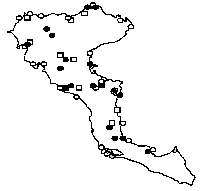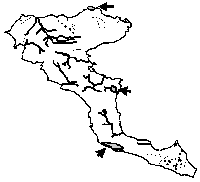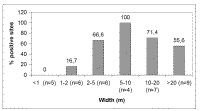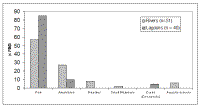 |
Last Update:
Thursday November 22, 2018
|
| [Home] |
|
Volume 23 Issue 1 Pages 1 - 48 (April 2006) Citation: Ruiz-Olmo, J. (2006) The Otter (Lutra lutra L.) on Corfu Island (Greece): Situation in 2006 IUCN Otter Spec. Group Bull. 23 (1): 17 - 25 The Otter (Lutra lutra L.) on Corfu Island (Greece): Situation in 2006 Jordi Ruiz-Olmo1 1 Direcció general del Medi Natural, Departament de Medi Ambient i Habitatge, Dr. Roux 80, 08017 - Barcelona, SPAIN. e-mail : ajruiol@gencat.net
While otters (Lutra lutra L.) have been endangered during the second half of the 20th century in most European countries (Mason and Macdonald, 1986; Macdonald and Mason, 1994), healthy populations remained in Greece during the decade of the 1980s (Macdonald and Mason, 1982, 1985; Gaethlich, 1988). Among Greek populations, the otter was detected on the Ionian island of Corfu (Kerkyra), and also the Euboea and Chios Islands, in the Aegean Sea. These islands are the only Mediterranean islands where the regular presence of otters has been reported (Macdonald and Mason, 1982; Gaethlich, 1988; Grémillet, 1995; Ruiz-Olmo, in press). During 1985-86, Gaethlich (1988) surveyed a total of eight 600m-length sites on Corfu Island. Otters were present in four sites, being detected in the rivers Melissoudi and Messonghi, and in the Korission lagoon. In 1990, Ruiz-Olmo (unpublished, in press) surveyed a total of 25 600m length sites (including some along the sea shoreline), the otter being detected on five (20%): rivers Melissoudi, Astrakeri and Messonghi, and again in the Korission lagoon. Grémillet (1993) surveyed a higher number of 2.000 m long sites during 1991 and 1992. This author found the otters in more localities, the species being found on the rivers Melissoudi, Dasia/Daphnila, Potamos and Messonghi, the lagoons of Antinioti, Aghios Stephanos and Chalkiopoulou, and the salinas of Alikes. Despite the considerable effort invested in looking for otters, this mustelid was absent from the remaining streams and water body masses. This author concluded that otters were absent on the Western coast of this island. After this, Urban (1998) and Ruiz-Olmo (in press) - the latter including some data from Michaela Bodner (pers. comm.), who surveyed some sites during the summer 2003 - also obtained some results. The otter was found in the rivers Messonghi, Ropas and Potamos, and in the Korission lagoon. According to these authors, the existence of such island populations in the Mediterranean sea may be explained by two factors: (a) the existence of a suitable habitat of high quality; and (b) the proximity of the continent, in the case of Corfu, the Albanian coast 2 km away where a healthy otter population was found by Prigioni et al. (1985). Despite these data, general reviews have pointed out the scarcity of whole surveys for the island (Conroy and Chanin, 2000; Ruiz-Olmo, in press). Due to the absence of Mediterranean island otter populations; these scarce island otter populations require special conservation efforts. However, some authors have pointed out the existence of important threats for these populations (Grémillet, 1993, 1995). The present work presents the results on the otter distribution on Corfu Island in spring 2006, together with some data on habitat preference. We also present the first data on otter diet there, and we deal with the current threats for this otter population. METHODS Corfu Island (592 km2) has an increasing human population of 130.000 (2001), compared to 99.447 inhabitants in 1981 (219 and 168 per square kilometer, respectively). In summer, the island population increases dramatically, and human density is also much higher. Distribution, breeding, habitat use and threats Otter distribution was assessed by means of a standard otter survey (Mason and Macdonald, 1986; Reuther et al., 2000), based on field observations. 600 m long sites were surveyed on both banks and in the middle of watercourses, in search of otter signs (spraints and tracks). In some cases, characteristic crab remains were noticed. In addition, at particular points, we carried out detailed searches (see Crawford, 2003), 1-25 m long often under or near bridges, looking for the same types of signs. The survey stopped when otter signs were discovered (Ruiz-Olmo and Delibes, 1998). All the rivers and streams and lagoons were surveyed, except Lefikimi/Chimaros River and Alikas salinas, in the southernmost area, because storms prevented us from completing this work (no extra days were available). For each site (including detailed search sites) we compiled the following data: river/waterbody name, place, length of the survey, results (presence/absence), signs found, presence of breeding evidence (cub tracks), apparent visual pollution level (see Ruiz-Olmo et al, 1998: very high, high, medium, low, null), river width (dry, < 0.5 m, 0.5-1m, 1-2m, 2-5m, 5-10m, 10-20m, >20m), vegetation cover of both banks (0%, 1-20%, 21-40%, 41-60%, 61-80%, 81-100%), observed threats and disturbances, and potential prey species recorded during the search. Diet Spraints were collected and conserved, and analyses were carried out following the methods described in Ruiz-Olmo and Palazón (1997). Results are presented as relative frequency of occurrence (RFO) (number of occurrences of the prey-item as a percentage of the total number of occurrences of all prey-items) and percentage of occurrence (%O) (= percentage of spraints containing the food category). StatisticsResults were compared by means of the chi-square test (Siegel, 1952). RESULTS Distribution A total of 55 sites were surveyed (Fig. 1a), the otter being detected in 19 of them (34.5%). 14 sites were surveyed at the sea shoreline – coast and ports - (excluding estuaries), all with negative results (0%). According to the data obtained, otters were found in most of the available freshwater habitat on the island (Fig. 1b). Otters were found in the catchments of the rivers Melissoudi, Dasia/Daphnila, Potamos, Messonghi, Petriti and Ropa, the Agios Giorigios River, and lagoons Antinioti, Chalkiopoulou/Halkiopoulos (where two otters were directly observed by us on April 14th) and Korission. Despite the fact that the rivers Astrakeri and Lefkimmi/Potami were not surveyed, the presence of the otter was suspected on the basis of the precedent data found in the literature.
Habitat use Otters preferred the widest rivers and medium freshwater streams and coastal lagoons, while the sea shoreline and the estuaries were avoided during the study (Fig. 2a). Otters were found significantly more often at watercourses 2-20 m wide in the lowlands (Fig. 2b). No effect of apparent water pollution was found (χ2 = 2.836, 2 d.f., P = 0.2422), but we surveyed only one site with a high apparent pollution level. This was also the case with the vegetation cover of banks (χ2 = 4.117, 2 d.f., P = 0.249); this may be an effect of the sample size, because, no site was found with 0% of vegetation cover (n=3), 38.5 % with 1-40 % (n = 11), 45.5 % with 41-80 % (n = 13) and 61.5 % when > 80 % (n = 13).
Evidence of breeding We found breeding evidence in the river Messonghi, near Messonghi city, where we found tracks of one small cub. DietA total of 48 otter spraints were collected and analyzed, containing a minimum of 91 prey-items (Fig. 3; Table 1). Fish were the main otter food, both in the rivers and streams and in the coastal lagoons. For the inland samples, a typical freshwater diet based on Cyprinids was found. The same was true for the lagoon samples, where migratory eurihaline fish were dominant. It was interesting that no representative of the dominant prey for each type of habitat was found in the other one.
In a 47.4% of the surveyed points inland (n=38) we found at least one kind of threat, disturbance or danger. In 23.7% of the cases we found buildings or new constructions on or near the bank; in 21.1% banks were destroyed or a channel had been built; in 15.8% a high tourist (people) level was found; in 13.2% the bank side vegetation was cut (as for example in the river Ropa and its tributaries on the Ermones golf course); in 7.8% professional fishing and angling activities (with no stopgrids in the fishnets); in 5.2% boat traffic or small ports; in 2.6 % hard works; and in 2.6% the use of chemicals and pesticides (posters warning people of the risks of these were again found on the same golf course). Rubbish was present to a high degree in most of the rivers, including in high mountain streams. In the marine habitats, we found at least one kind of threat, disturbance or danger, in 75% of the surveyed sites (n=12). 50% of the surveyed sites presented a high tourist level; 33.3% of the coastal sites surveyed were altered; in 25% we found construction in progress; and in 16.7% the presence of buildings along the shore was found. DISCUSSION According to our findings, otters are widespread in the rivers and streams of Corfu island, the species being very scarce or absent from the marine habitats. These results are in total agreement with earlier works (Grémillet, 1993; Ruiz-Olmo, in press). As the surveys carried out during the decades of the 80s and 90s (20th century) showed the lack of the otter in some areas or rivers of the island (for instance the west part) (see Introduction), a recovery or recolonization of the island could explain the present range. It is important to remember that in Corfu this mustelid lives in Mediterranean habitats, the watercourses drying during summer or during droughts (see Grémillet, 1993, 1995). A water dependent dynamic may explain such changes in distribution. However, comparing distributions for different years, the first theory seems to be more consistent. On the other hand, otters are still breeding on Corfu, according to our finding of cub’s tracks. Grémillet (1993, 1995) also found other evidence of otter breeding in several parts of the island. Otters present a typical diet pattern, based mostly on the fish consumption in both rivers and streams. Potential prey-species are less diverse on the island than on the continent (Delaki et al., 1993; Ruiz-Olmo and Palazón, 1997), so these otters have lower diet diversity, and this has been suggested as a potential problem for the long-term conservation of the species (Ruiz-Olmo and Palazón, 1997; Ruiz-Olmo et al., 2001). Fluctuations in such low diversity prey communities can severely affect food availability and, for this reason, increase mortality, decrease breeding success and migration. The otter has shown a trend of increasing population during the last 20 years, even though Corfu island is still undergoing important changes that could affect otters soon. The conservation problems that Grémillet (1993, 1995) pointed out are still being realized. Amongst them we would like to note:
As Greece forms part of the European Union, and the otter is among the species included in annexes II and IV of the Habitats Directive (1992), the species should be effectively protected. Also, as the Mediterranean island otter populations are so scarce, an important part of the freshwater Mediterranean Islands otter habitat must be included in the Natura 2000 protected network. At the moment only a few areas are proposed to be included as a part of this Network by the Greek Government. Of these, all are coastal wetlands (lagoons). No rivers or streams including known otter populations are included. The nearest Albanian and Greek otter populations must be healthy, as the Corfu ones may depend on these for recolonization and avoiding the effect of inbreeding (there is no estimate of the Corfu’s otter population). To assure the conservation of these island populations, the maximum quantity of habitat has to be protected. Acknowledgements - To Montserrat Sagalés and Marc Ruiz-Sagalés for their collaboration during the field survey. Ricard Gutierrez revised the manuscript. REFERENCES Conroy, J.W.H., Chanin, P. (2000). The status of the Eurasian Otter (Lutra lutra) in Europe- A review. In: Proceedings of the First Otter Toxicology Conference (Ed. by J. Conroy, P. Yoxon & A.C. Gutleb), Isle of Skye, September 2000. J. Int. Otter Surv. Fund, 1: 7-28. Resúmen |
| [Copyright © 2006 - 2050 IUCN/SSC OSG] | [Home] | [Contact Us] |





